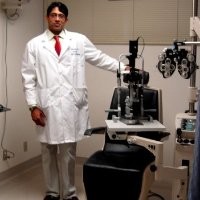Revolutionizing Eye Tracking with Deflectometry: A Breakthrough by the University of Arizona
Eye tracking is a crucial aspect of several fields, including entertainment, medical science, automotive assistance, and industrial engineering. It is a fundamental component in augmented and virtual reality headsets. However, tracking the human eye’s movements with high precision is a complex challenge.
A ground-breaking study by researchers at the University of Arizona Wyant College of Optical Sciences has uncovered an innovative method that has the potential to transform eye tracking technology. The study, published in Nature Communications, uses an amalgamation of deflectometry, a powerful 3D imaging technique, and advanced computation to enhance the accuracy of eye tracking.
The conventional methods of eye tracking can only capture directional information from a handful of surface points on the eyeball. In contrast, the new deflectometry-based approach can extract information from over 40,000 surface points from a single camera image. This method can potentially increase the accuracy of gaze direction estimation, which is particularly essential for next-generation applications in virtual reality.
Deflectometry is a 3D imaging technique typically used to measure reflective surfaces with high precision. It is particularly used to scan large telescope mirrors or other high-performance optics for minute imperfections. By combining deflectometry with computational methods used in computer vision research, the researchers at the University of Arizona have developed a new field known as “computational deflectometry.”
During their study, the team conducted experiments with human subjects and a realistic artificial eye model. They were able to track the subjects’ gaze direction with impressive accuracy. Their new method uses a screen displaying known structured light patterns as the illumination source, with each pixel acting as an individual point light source. By analyzing the deformation of the patterns as they reflect off the eye surface, accurate 3D surface data from both the cornea and the sclera can be obtained.
The researchers believe that their technology can easily integrate with virtual reality and augmented reality systems, significantly reducing system complexity. Future versions could use infrared light, allowing the system to operate without distracting the user with visible patterns.
A notable additional benefit of the new technology is its ability to provide a detailed and accurate surface reconstruction of the eye, which could be used for instantaneous diagnosis and correction of specific eye disorders in the future.
While this is the first use of deflectometry for eye tracking, the initial results have already shown accuracy comparable to or better than commercial eye-tracking systems. The researchers are hopeful that with further refinements, they can push the boundaries of eye tracking beyond what has been previously achieved. They aim to reach 0.1-degree accuracy levels and believe their new method could pave the way for the next wave of advanced eye tracking technology.
This innovative study is a collaboration between Florian Willomitzer, associate professor of optical sciences, Jiazhang Wang, postdoctoral researcher, Oliver Cossairt, adjunct associate professor of electrical and computer engineering at Northwestern University, and former Northwestern students Tianfu Wang and Bingjie Xu. The team plans to incorporate other 3D reconstruction methods and leverage artificial intelligence to further enhance their technique. Their research opens up new possibilities in fields like neuroscience research and psychology.

Comments are closed for this post.